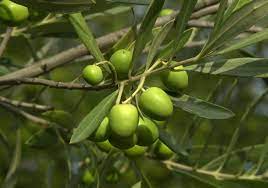Olea europaea, commonly known as the Olive tree, is a versatile evergreen tree that thrives in the Irish climate. It is highly sought after for its attractive appearance and culinary uses.
Height/Spread: Olive trees (Olea europaea) typically grow to a height of 20-40 feet (6-12 meters) with a spread of 15-30 feet (4.5-9 meters), creating an impressive presence in the landscape. However, they can be pruned and maintained at smaller sizes for container planting or as ornamental specimens.
Position: Olive trees prefer a sunny and sheltered position in the Irish climate. They require a location that receives full sun exposure for a significant part of the day, ensuring optimal growth and fruit production. Additionally, it is essential to protect them from strong winds, especially in colder regions.
Soil: Olive trees are adaptable to a range of soil types but thrive in well-draining, moderately fertile soils. In the Irish climate, it is crucial to ensure the soil is sufficiently free-draining and not prone to waterlogging, as excess moisture can be detrimental to olive tree health.
Flowering Season: Olive trees produce small, fragrant, cream-colored flowers in late spring or early summer. However, in the Irish climate, the flowering season may vary depending on local conditions. The flowers give way to small green fruits that gradually ripen to a dark purple or black color in the autumn.
Uses: Olive trees have multiple uses in the Irish climate. They are often planted for their ornamental value, adding a touch of Mediterranean charm to gardens and landscapes. Additionally, olive trees are renowned for their fruit production and are cultivated for the harvesting of olives, which can be used for culinary purposes, such as olive oil and table olives. Their durable wood is also used in crafting and woodworking projects.
Height/Spread: Olive trees (Olea europaea) typically grow to a height of 20-40 feet (6-12 meters) with a spread of 15-30 feet (4.5-9 meters), creating an impressive presence in the landscape. However, they can be pruned and maintained at smaller sizes for container planting or as ornamental specimens.
Position: Olive trees prefer a sunny and sheltered position in the Irish climate. They require a location that receives full sun exposure for a significant part of the day, ensuring optimal growth and fruit production. Additionally, it is essential to protect them from strong winds, especially in colder regions.
Soil: Olive trees are adaptable to a range of soil types but thrive in well-draining, moderately fertile soils. In the Irish climate, it is crucial to ensure the soil is sufficiently free-draining and not prone to waterlogging, as excess moisture can be detrimental to olive tree health.
Flowering Season: Olive trees produce small, fragrant, cream-colored flowers in late spring or early summer. However, in the Irish climate, the flowering season may vary depending on local conditions. The flowers give way to small green fruits that gradually ripen to a dark purple or black color in the autumn.
Uses: Olive trees have multiple uses in the Irish climate. They are often planted for their ornamental value, adding a touch of Mediterranean charm to gardens and landscapes. Additionally, olive trees are renowned for their fruit production and are cultivated for the harvesting of olives, which can be used for culinary purposes, such as olive oil and table olives. Their durable wood is also used in crafting and woodworking projects.
You may also like
Recently viewed







